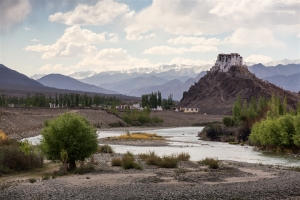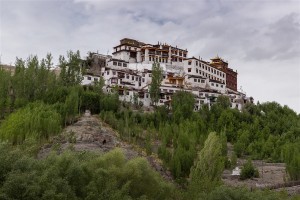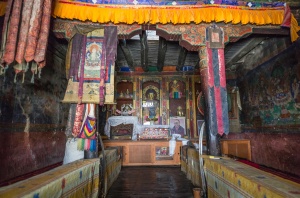In the far north of India set within the Himalayas lies Ladakh. Known as “Little Tibet”, it is a land of dramatic landscapes and mystical Buddhist monasteries.
This is my introduction to the region, detailing what can be seen :
- West of Leh – all reachable as a day excursion from Leh, but you won’t have time to see everything !
- East of Leh – again, all are accessible from Leh as a day excursion.
- In Leh Town – what can be seen on foot around Leh.
- On longer excursions from Leh – the classic trips to Pangong Tso and Nubra Valley.
The links above can help you navigate to the appropriate sections, and each place listed is itself linked to a more detailed blog post about my visit to that location.
I’ve been spell-bound by Ladakh, twice in two years, and I suspect it won’t be long before I’m drawn back to this magical place. I hope this post will help others get the most out of their stay there.
West of Leh
 Spitok Gompa
Spitok Gompa
8km from Leh
Close to Leh and an easy two hour excursion from the town.
Perhaps one of the most beautifully sited monasteries in the whole of Ladakh.
 Phyang Gompa
Phyang Gompa
17km from Leh
Dating back to the 16th century, King Tashi Namgyal was keen on founding the monastery to atone for a terrible crime he committed – blinding and expelling his elder brother in order to gain the throne.
 Basgo
Basgo
40km from Leh
A Palace, hidden giant Buddha’s, mountains and valleys.
Basgo has it all, and so often overlooked by visitors to the region.
 Likir Gompa
Likir Gompa
53km from Leh
See the colossal open-air Maitreya (Future Buddha), a relatively new addition to the monastery.
Built on a hill long thought to be the resting place of the snake gods.
 Saspol Caves
Saspol Caves
60km from Leh
A series of amazing rock-cut temples.
Four of the caves are richly adorned with paintings of Buddhist pantheon from 13th – 15th century AD, representing a fusion of Indian and Tibetan Buddhist art.
 Alchi Gompa
Alchi Gompa
69km from Leh
The 12th century shrines, abandoned in the 15th century, boast the most magnificent murals in all of Ladakh.
Possibly the most popular day excursion from Leh.
 Mangyu Gompa
Mangyu Gompa
70km from Leh
As old as Alchi, Mangyu Gompa is one of Ladakh’s most historic monasteries
It is often one that is overlooked by those visiting the region.
 Rizong Gompa
Rizong Gompa
75km from Leh
One of Ladakh’s newest and yet most isolated Gompas.
Founded in 1833, there are no settlements nearby and the monastery enforces a very strict regime of Buddhist discipline.
 Temisgam Gompa
Temisgam Gompa
92km from Leh
Once a capital of western Ladakh.
With a ruined castle dating back to the 15th century and three old temples.
 Lamayuru Gompa
Lamayuru Gompa
125km from Leh
With a mystique quite unlike any other Ladakhi monastery.
Remote and isolated, and yet not secluded.
 Wanla Gompa
Wanla Gompa
132km from Leh
An ancient and historic monastery believed to date back 1,000 years.
Founded by Richen Zangpo, who was one of the greatest translators of Buddhist texts.
East of Leh
 Shey Gompa
Shey Gompa
15km from Leh
Was the ancient capital of Ladakh as far back as the 10th century.
The highlight of a visit is to see the temple which enshrines a giant seated Buddha.
 Thikse Gompa
Thikse Gompa
19km from Leh
Built in the 1480s by Palden Shesrab Zangpo, there are now 120 lamas residing in the monastery. Thikse is considered one of the richest in the Ladakh region.
 Stakna Gompa
Stakna Gompa
25km from Leh
Perched on a dramatic pyramidal hill.
One of the most spectacular settlings for a monastery in Ladakh.
 Matho Gompa
Matho Gompa
26km from Leh
Off the popular tourist trail and rarely sees any visitors.
Nestled high up on a crag on the far side of the river Indus, it’s well worth a visit for the astonishing views the monastery commands.
 Hemis Gompa
Hemis Gompa
43km from Leh
Ladakh’s wealthiest monastery.
Home to the “Jesus Scroll”, a Tibetan manuscript translated from the ancient Indian language of Pali that tells the story of Jesus Christ and his hypothesised travels in India.
 Chemde Gompa
Chemde Gompa
45km from Leh
Built around 1645, it was founded by Stag-tsang-ras-pa under royal patronage.
Today is home to around 100 lamas.
 Thag-Thok Gompa
Thag-Thok Gompa
Much of the monastery was only constructed 100 years ago, but it has grown out of a cave hermitage where Padmasambhava (Guru Rimpoche) is believed to have once meditated.
Leh Town
 Chamba Lhakhang
Chamba Lhakhang
Near Leh Palace.
Restored by THF, and pre-dates Leh Palace by some 200 years.
It is thought to have been built by King Tragspa-bum-ide, who ruled during the first half of the 15th century.
Access is limited, it is best visited as part of the Leh Heritage Walk.
 Guru Lhakhang
Guru Lhakhang
Near Leh Palace.
One of four temples that are considered part of the Leh palace complex in Ladakh.
It is probably the hardest to reach on foot, being located immediately below Leh Palace with no easily identifiable path to it from Leh old town.
The best time to try and see this temple is early in the morning.
 Chenrezig Lhakhang
Chenrezig Lhakhang
Near Leh Palace.
Dedicated to Avalokiteswara, the Buddha of Compassion.
It is believed to have been built in the 17th century by King Deldan Namgyal, who reigned over the Ladakh region from 1642 to 1694.
 Jokhang Gompa
Jokhang Gompa
Near Leh’s Main Bazaar.
A large modern gompa just around the corner from Leh’s Main Bazaar. It”s also the location of the Ladakhi Buddhist Association, a conservative political organisation with ties to Hindutva groups.
 Leh Heritage Walk
Leh Heritage Walk
Starts at Lala’s Cafe, Old Leh.
See the amazing work being conducted by THF/LOTI in Leh’s old town, trying to preserve the rapidly disappearing heritage of the town.
A highlight of a stay in Leh.
 Leh Old Fort
Leh Old Fort
Leh’s first royal residence, and just like all Ladakhi capitals, Leh too had its first fortress built at the highest elevations.
With the passing of time and the kings becoming more confident, subsequent palaces were built at more accessible lower elevations.
 Leh Palace
Leh Palace
The most dominant building in Leh.
Without doubt one of Ladakh’s most imposing structures, dominating the landscape around Leh it’s impossible to ignore, it’s ever present, and both amazes and awes all visitors to the region.
 Namgyal Tsemo Gompa
Namgyal Tsemo Gompa
Housing a giant image of Maitreya, the Future Buddha, sitting within a two storey shrine flanked by Avalokiteswara and Manjushri, the Buddha of Wisdom.
The walls are richly decorated and vibrant, it’s well worth the climb to view this temple.
 Shanti Stupa
Shanti Stupa
On the western side of Leh Valley.
Built by the ‘Peace Sect’, an association of Japanese Buddhists, the Shanti Stupa crowns a hill on the western edge of the Leh valley.
A total of 157 steps take you to the summit.
 Soma Gompa
Soma Gompa
Built in 1840 by Lama Tashi Tenpel.
This was until the 1950s one of the main Buddhist temples in Leh before a new and much larger temple was built down below on the Main Bazaar Road.
Excursions from Leh
 Pangong Tso
Pangong Tso
Located in the eastern highlands of Changthang bordering Tibet.
Pangong Tso is one of Ladakh’s most spectacular and popular destinations.
The drive to the lakes is simply breathtaking !
 Khardung La Pass (to Nubra Valley)
Khardung La Pass (to Nubra Valley)
At an elevation of 18,379 ft, the Khardung La is the world’s highest motorable road.
Get that top-of-the-world feeling !
It serves as gateway to the Nubra Valley.
 Diskit Gompa (Nubra Valley)
Diskit Gompa (Nubra Valley)
Dating back to the 15th century, Diskit Gompa is Nubra’s most historic monument.
Situated 150m above the village of the same name, the zig-zag road up passes by the new giant 32 meter high statue of Maitreya (the Future Buddha).
 Samstanling Gompa (Nubra Valley)
Samstanling Gompa (Nubra Valley)
Founded in 1841 by Lama Tsultrim Nima, and set within an awesome landscape.
Inaugurated by the Dalai Lama in 1962.
Home to about 50 monks.
 Turtuk (Nubra Valley)
Turtuk (Nubra Valley)
An oasis amidst the arid mountains.
Surrounded by rich cultivated fields and apricot orchards.
The most memorable journey anyone can take in the Nubra Valley.
You’re welcome to ‘Like’ or add a comment if you enjoyed this blog post. If you’d like to be notified of any new content, why not sign up by clicking the ‘Follow’ button.
If you’re interested in using any of my photography or articles please get in touch. I’m also available for any freelance work worldwide, my duffel bag is always packed ready to go…
KevinStandage1@googlemail.com
Categories: India, Jammu & Kashmir, Ladakh, Ladakh - An Introduction





It’s great…!!
LikeLiked by 1 person
Thanks, and so is Ladakh !
LikeLiked by 1 person
Hello Kevin, loved your posts on Ladakh! Am planning to explore the region next year and have in fact bookmarked your posts for reference. 🙂 If I may ask, how much time would one need to see Ladakh properly–or rather how many days did YOU spend, all in all, there?
LikeLiked by 1 person
Namaste Rama ! Good question…I have in fact been twice purely because my first visit of about 10 days simply wasn’t enough time. The two main excursions out of Leh which you’re likely to want to do are Nubra Valley and Pangong Lakes. Nubra Valley demands 2-3 days there plus a days traveling there and back, Pangong is shorter but it’s still a days travel to get there and back. So doing both of those will consume at least a week with a pretty full on itinerary. Add to that all the other day excursions out of Leh to the monasteries (getting to Saspol Caves, Basgo and Lamayuru is also a must), the days start to add up. I would suggest two weeks as a minimum, to see everything I have blogged about would be about 20 days which would include a few quieter days just to explore Leh itself on foot. On both occasions I stayed at Padma Guest House, great location and really helpful management, I’d thoroughly recommend this place.
LikeLiked by 2 people
Thanks so much for sharing! Deeply appreciated. You are a great photographer. Am super excited about my Ladakh trip — way more after reading your posts. Thank you. 🙂
LikeLiked by 1 person
Depending on when you go, you may be able to attend one of the monastery festivals, which are simply unforgettable ! This does of course use up more days, and you will need to get there early to claim your viewing spot. This seems like a reliable source for knowing when the festival days are, Hemis is the best choice if you’re able to do this 🙂
https://www.gesar-travel.com/monastery-festivals-ladakh-dates-2018/?lang=en
LikeLiked by 2 people